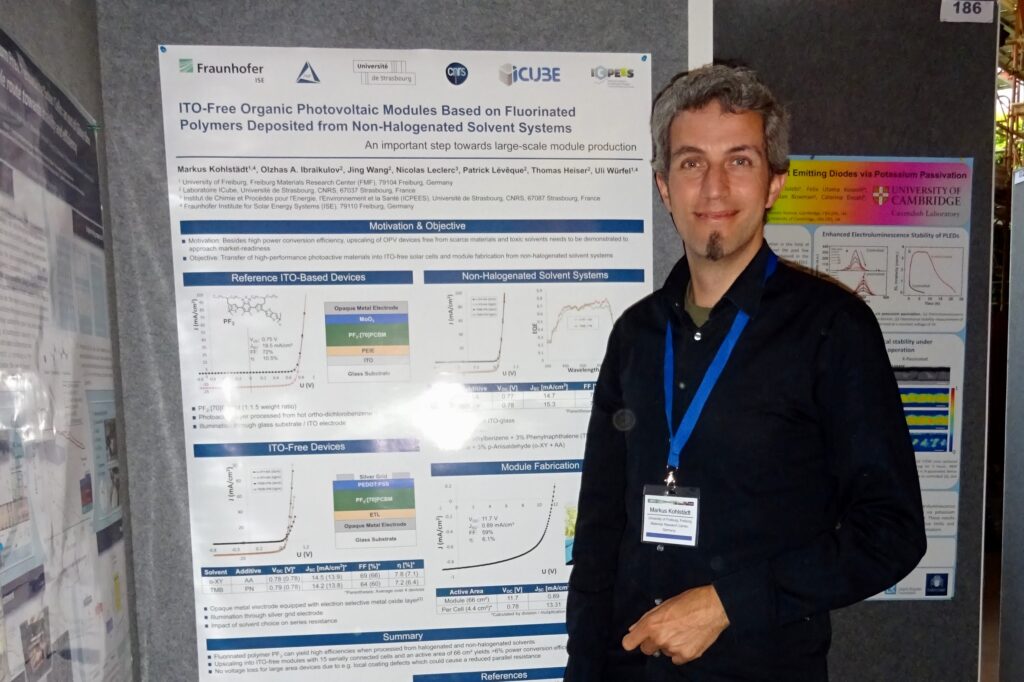Markus Kohlstädt präsentierte ein Poster auf der International Conference on Hybrid and Organic Photovoltaics (HOPV19) in Rom, Italien, vom 12. bis 15. Mai 2019.


Abstract:
ITO-free organic photovoltaic modules based on fluorinated polymers deposited from non-halogenated solution: an important step towards large-scale module production
Markus Kohlstädt (1), O.A. Ibraikulov (2), J. Wang (2), N. Leclerc (3), P. Lévèque (2), T. Heiser (2), Uli Wuerfel (1,4)
(1) Freiburg Materials Research Center FMF, University of Freiburg, Stefan-Meier-Str. 21, 79104 Freiburg, Germany
(2) Laboratoire ICube, Université de Strasbourg, CNRS, UMR 7357, 23 rue du Loess, 67037 Strasbourg, France.
(3) Institut de Chimie et Procédés pour l’Energie, l’Environnement et la Santé (ICPEES), Université de Strasbourg, CNRS, UMR 7515, 25 rue Becquerel, 67087 Strasbourg, France.
(4) Fraunhofer Institute for Solar Energy Systems ISE, Heidenhofstr. 2, 79110 Freiburg, Germany
Organic photovoltaics (OPV) with bulk heterojunction photoactive layers have recently reached a certified power conversion efficiency of 14.9% for single junction solar-cells1. These high efficiencies have been obtained using, most of the time, fluorinated polymers2 as electron-donor material and non-fullerene acceptors (NFAs3) as electron-acceptor material and represent a significant step to prove the commercial interest of OPV.
Besides high efficiency, scaling up of OPV lab-scale devices into larger area modules free from scarce materials (e.g. indium) and fabricated without the use of halogenated solvents and/or harmful additives needs to be demonstrated to approach market-readiness. We recently published photovoltaic results obtained with an electron-donating fluorinated copolymer4 together with a fullerene derivative, demonstrating an efficiency of more than 10% on 12 mm2 photovoltaic devices prepared from hot o-DCB solution and using an Indium-containing electrode. In the present study, non-halogenated solvents and harmless additives have been employed together in order to reach similar efficiencies on lab-scale and ITO-containing devices. Furthermore, we could successfully transfer the fabrication process for the realization of small scale ITO-free devices with 7.8% efficiency, in which the photoactive layer was deposited from an o-Xylene/p-Anisaldehyde mixture. The devices contained substrate-sided opaque metal electrodes and a metal grid electrode on top of the cell stack, similar to an architecture we have published before5. After a scale-up of the fluorinated-polymer synthesis, ITO-free OPV modules with an active area of 66 cm² and power conversion efficiency above 6% have been manufactured. By employing a shunt-proof opaque electrode, no voltage losses have been observed after monolithic serial interconnection of the 15 individual cells, which could have been caused e.g. by reduced parallel resistance due to local coating defects. Currently, further experiments with other non-halogenated solvents and additives to further increase the power conversion efficiency are performed.
References
1. J. Yuan, et al. Joule (2019, in press).
2. N. Leclerc, et al. Polymers 8, 11 (2016).
3. P. Cheng, et al. Nat. Photonics 12, 131–142 (2018).
4. O. A. Ibraikulov, et al. J. Mater. Chem. A 6, 12038–12045 (2018).
5. S. B. Sapkota, et al. Sol. Energy Mater. Sol. Cells 130, 144–150 (2014).
Link :https://www.nanoge.org/proceedings/HOPV19/5cac680ddbd48b5f89b73e33

1 comment for “PROOF-Projekt auf der Internationalen Konferenz über hybride und organische Photovoltaik in Roma”